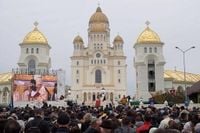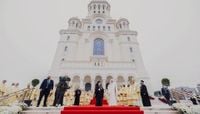On Sunday, October 26, 2025, Bucharest’s skyline was transformed by an event of profound religious and national significance. Thousands of pilgrims, dignitaries, and clergy converged on Romania’s capital for the consecration of the mosaic iconography inside the People’s Salvation Cathedral—also known as the National Cathedral—the world’s largest Orthodox Christian church. The ceremony, led by Ecumenical Patriarch Bartholomew I of Constantinople and Romanian Patriarch Daniel, marked not just a spiritual milestone but also a defining chapter in the country’s modern story.
The cathedral, standing a towering 135 meters tall including its cross, dominates Arsenal Hill across from the imposing Palace of Parliament. Its 38,000-square-meter footprint and capacity for up to 6,000 worshippers inside (and 125,000 in the surrounding complex) make it a true architectural marvel, surpassing even Moscow’s famed Cathedral of Christ the Saviour. Its construction, a blend of Byzantine inspiration and modern engineering, is earthquake-resistant up to 8.5 on the Richter scale, a testament to both ambition and caution in a region prone to seismic activity (as reported by Basilica.ro and Euronews Romania).
The consecration was a spectacle in itself. Over 2,500 official guests—among them Romanian President Nicusor Dan with his family, Moldovan President Maia Sandu, Prime Minister Ilie Bolojan, senior clergy, diplomats, and even former heads of state—were joined by thousands more who watched the service unfold live on large screens outside. Security was tight, with more than 800 gendarmes ensuring order as more than 8,000 clergy and believers filled the cathedral’s esplanade (according to Basilica.ro).
The ceremony was steeped in tradition and symbolism. Three Gospel passages were read by Patriarch Bartholomew I, Patriarch Daniel, and Metropolitan Teofan of Moldavia and Bukovina. The patriarchs blessed the newly completed mosaic icons of Saints Andrew and Philip, anointed the cathedral’s doors and altar with holy oil, and consecrated two silver reliquaries containing relics of Saint Dionysius of Vatopedi and Saint Petronius of Prodromu. Simultaneously, Romanian hierarchs consecrated both the exterior and interior mosaics—an intricate iconographic ensemble that now ranks among the largest in the Orthodox world, with 25,000 square meters of mosaics completed between 2019 and 2025 (as reported by Euronews Romania and The Independent).
For many, the day’s events were the culmination of a dream more than a century in the making. The idea of a national cathedral in Bucharest dates back to 1884, when King Carol I first initiated legislation to build such a monument. Yet, wars and political upheaval—including decades of communist rule that sought to suppress religious expression—delayed the project for generations. Construction only began in earnest in 2010, spearheaded by Patriarch Daniel. The altar was consecrated in 2018, and the cathedral has since become a symbol of both national resilience and spiritual continuity. As The Independent noted, the Romanian Orthodox Church has described the cathedral as “a symbol of national identity.”
Patriarch Daniel, reflecting on the journey, expressed gratitude to the Romanian governments from 2010 to 2025 for their support. He described the cathedral as “a construction born from the dream and faith of many Romanians, which reminds us how important patience, trust and hope are when we build together.” His words were echoed by President Nicusor Dan, who attended the ceremony with his family and later remarked on social media that the cathedral “reminds us how important patience, trust and hope are when we build together.”
Ecumenical Patriarch Bartholomew I, in his address, praised the cathedral’s Byzantine mosaic art, saying, “the painting in this most beautiful place of worship, in a special way, mysteriously and truly brings heaven down to earth.” He emphasized that the “impressive and overwhelming” dimensions of the National Cathedral “testify to the importance and magnitude of these celebrations related to the self-determination and dignity of the Romanian Patriarchate.” Bartholomew I also highlighted the enduring faith of the Romanian people, noting, “even in the darkest hours, [the faith] has never been abandoned by the good people of this land so rich and fruitful from a spiritual point of view.”
The cathedral’s grandeur extends beyond its spiritual mission. Its iconostasis, measuring 23 meters long and 17 meters high, stands as one of the largest in the world. The six bells, including Europe’s largest—over 25 tons and audible up to 15 kilometers—add to its impressive features. Visitors can ascend to a viewing platform 71 meters above ground, offering sweeping vistas of Bucharest. Architect Constantin Amâiei, who coordinated the design, explained to Digi24 that the cathedral’s scale was determined in consultation with the Patriarchate and that the exterior area will eventually become a public space, seamlessly connecting with Parcul Izvor and the Palace of Parliament.
Yet not everyone is convinced the cathedral’s massive scale and cost—estimated at over 270 million euros ($313 million), mostly from public funds—are justified. Romania faces one of the largest budget deficits in the European Union, and critics have argued that the money could have been better spent on schools or hospitals. Claudiu Tufis, a political science professor at the University of Bucharest, told the Associated Press, “The fact that they have forced, year after year, politicians to pay for it, in some cases taking money from communities that really needed that money, indicates it was a show of force, not one of humility and love of God.” He conceded, however, that “economically, it might be OK in the long term as it will be a tourist attraction.”
Supporters counter that the cathedral is already a unifying symbol for a nation where roughly 85% of the 19 million citizens identify as religious, making Romania one of the most devout countries in the European Union. Rares Ghiorghies, a 37-year-old supporter, acknowledged the financial debate but insisted, “The big problem in society is that most of those who criticize do not follow the activities of the church.”
The cathedral’s role as a focal point for national celebrations was underscored by its timing: the ceremony marked both the centenary of the Romanian Patriarchate and the 140th anniversary of the Romanian Orthodox Church’s autocephaly. Pope Francis’s visit in 2019 further highlighted its international religious importance. As part of the week’s festivities, the cathedral remained open 24/7 for public prayer until October 31, drawing even more pilgrims and visitors to its soaring halls.
While some interior spaces remain unfinished and further construction is planned—including adjacent buildings and a Cathedral Park—architect Amâiei estimates that, if the current pace continues, the entire complex could be completed within the next three to four years. For now, the cathedral stands as a testament to the enduring faith, ambition, and complexity of modern Romania—a place where dreams, controversy, and tradition meet under one spectacular roof.

